Citroen JUMPY MULTISPACE 2011 2.G Service Manual
Manufacturer: CITROEN, Model Year: 2011, Model line: JUMPY MULTISPACE, Model: Citroen JUMPY MULTISPACE 2011 2.GPages: 268, PDF Size: 10.1 MB
Page 41 of 268
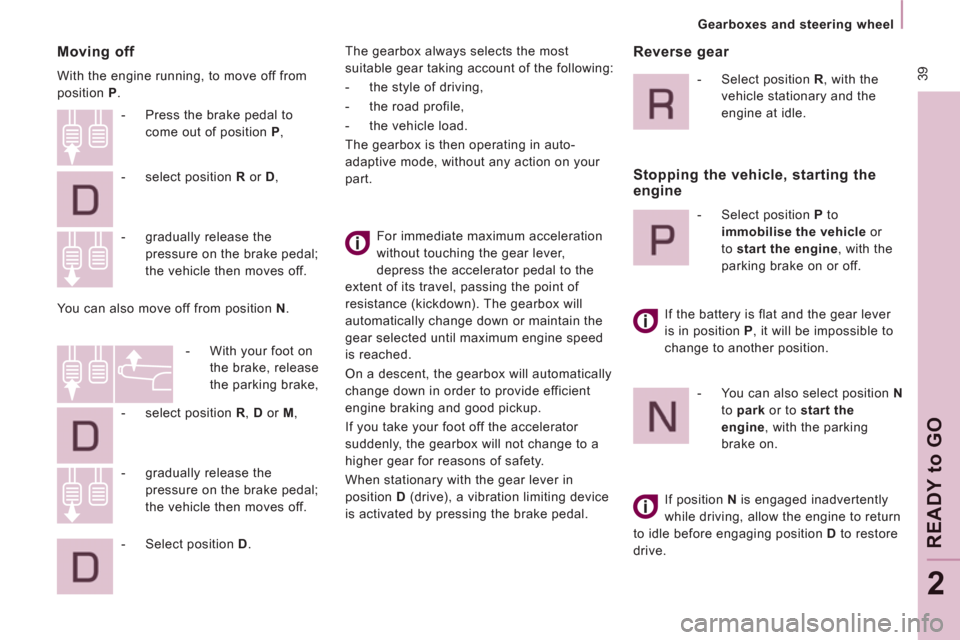
39
Gearboxes and steering wheel
READY to GO
2
Moving off
With the engine running, to move off from
position P
.
For immediate maximum acceleration
without touching the gear lever,
depress the accelerator pedal to the
extent of its travel, passing the point of
resistance (kickdown). The gearbox will
automatically change down or maintain the
gear selected until maximum engine speed
is reached.
On a descent, the gearbox will automatically
change down in order to provide efficient
engine braking and good pickup.
If you take your foot off the accelerator
suddenly, the gearbox will not change to a
higher gear for reasons of safety.
When stationary with the gear lever in
position D
(drive), a vibration limiting device
is activated by pressing the brake pedal.
- gradually release the
pressure on the brake pedal;
the vehicle then moves off.
- Press the brake pedal to
come out of position P
,
- select position R
or D
,
- gradually release the
pressure on the brake pedal;
the vehicle then moves off.
You can also move off from position N
.
- With your foot on
the brake, release
the parking brake,
- select position R
, D
or M
,
- Select position D
. The gearbox always selects the most
suitable gear taking account of the following:
- the style of driving,
- the road profile,
- the vehicle load.
The gearbox is then operating in auto-
adaptive mode, without any action on your
part.
Reverse gear
- Select position R
, with the
vehicle stationary and the
engine at idle.
Stopping the vehicle, starting the
engine
- Select position P
to
immobilise the vehicle
or
to start the engine
, with the
parking brake on or off.
If the battery is flat and the gear lever
is in position P
, it will be impossible to
change to another position.
- You can also select position N
to park
or to start the
engine
, with the parking
brake on.
If position N
is engaged inadvertently
while driving, allow the engine to return
to idle before engaging position D
to restore
drive.
Page 42 of 268
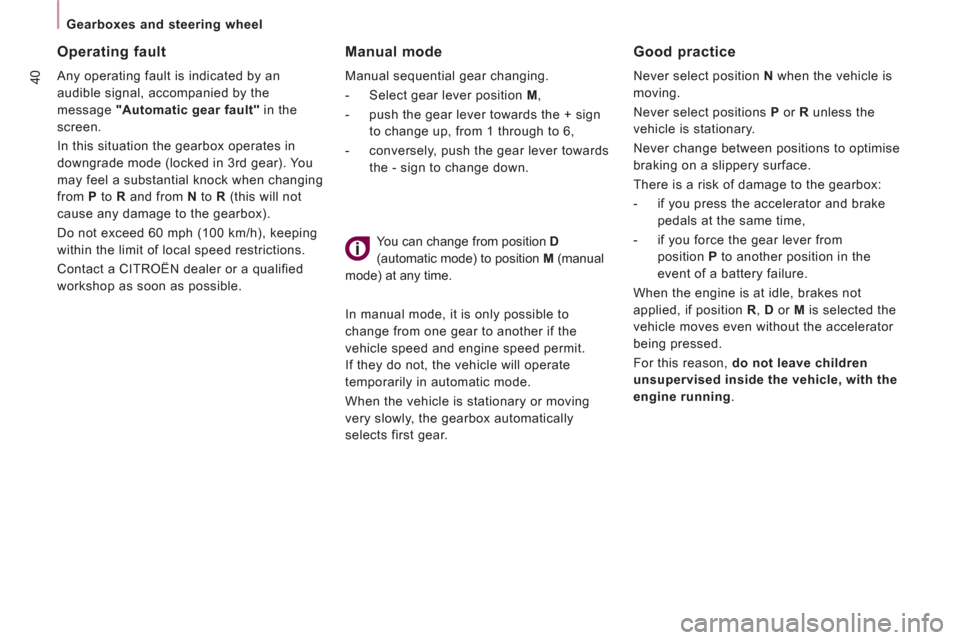
40
Gearboxes and steering wheel
Manual mode
Manual sequential gear changing.
- Select gear lever position M
,
- push the gear lever towards the + sign
to change up, from 1 through to 6,
- conversely, push the gear lever towards
the - sign to change down.
In manual mode, it is only possible to
change from one gear to another if the
vehicle speed and engine speed permit.
If they do not, the vehicle will operate
temporarily in automatic mode.
When the vehicle is stationary or moving
very slowly, the gearbox automatically
selects first gear. You can change from position D
(automatic mode) to position M
(manual
mode) at any time.
Good practice
Never select position N
when the vehicle is
moving.
Never select positions P
or R
unless the
vehicle is stationary.
Never change between positions to optimise
braking on a slippery surface.
There is a risk of damage to the gearbox:
- if you press the accelerator and brake
pedals at the same time,
- if you force the gear lever from
position P
to another position in the
event of a battery failure.
When the engine is at idle, brakes not
applied, if position R
, D
or M
is selected the
vehicle moves even without the accelerator
being pressed.
For this reason, do not leave children
unsupervised inside the vehicle, with the
engine running
.
Operating fault
Any operating fault is indicated by an
audible signal, accompanied by the
message "Automatic gear fault"
in the
screen.
In this situation the gearbox operates in
downgrade mode (locked in 3rd gear). You
may feel a substantial knock when changing
from P
to R
and from N
to R
(this will not
cause any damage to the gearbox).
Do not exceed 60 mph (100 km/h), keeping
within the limit of local speed restrictions.
Contact a CITROËN dealer or a qualified
workshop as soon as possible.
Page 43 of 268

41
READY to GO
2
STARTING AND STOPPING
Key
Take care to prevent the key from coming
into contact with grease, dust, rain or a
damp environment.
A heavy object attached to the key
(key ring, ...) weighing the key down in the
ignition switch may cause a malfunction.
Starting position.
The starter is operated, the engine turns
over, release the key.
STOP position:
steering lock.
The ignition is off. Turn the steering wheel
until the steering locks. Remove the key.
Good practice when starting
If this comes on, a door or the
bonnet is not closed correctly,
check!
Diesel pre-heating warning light
If the temperature is high enough,
the warning light comes on for
less than one second, you can
start without waiting.
In cold weather, wait for this warning light to
switch off then operate the starter (Starting
position) until the engine starts.
Good practice when stopping
Minimise engine and gearbox wear
When switching off the ignition, let the
engine run for a few seconds to allow the
turbocharger (Diesel engine) to return to idle.
Do not press the accelerator when switching
off the ignition.
There is no need to engage a gear after
parking the vehicle.
Running and accessories position.
To unlock the steering, turn the steering
wheel gently while turning the key, without
forcing. In this position, certain accessories
can be used.
Door or bonnet open warning light
STEERING WHEEL HEIGHT ANDDEPTH ADJUSTMENT
When the vehicle is stationary, unlock the
steering wheel by lowering the lever.
Adjust the height and depth of the steering
wheel, then lock by pushing the lever fully
upwards.
Starting and stopping
Gearboxes and steering wheel
Page 44 of 268

42
Steering mounted controls
Dipped beam/main beam change
Pull the stalk fully towards you. Automatic lights
if your vehicle is fitted with
a brightness sensor. Lights off
Dipped beam (green)
Main beam (blue)
LIGHTING CONTROL
STEERING MOUNTED CONTROLS
Side lights
Lights-on buzzer
When the ignition is switched off, when the
driver's door is opened, a buzzer sounds if
you have left your lights on.
DIRECTION INDICATORS (flashing)
Left
: downwards passing
the point of resistance.
Right
: upwards passing
the point of resistance.
Front and rear lights
Selection is by turning ring A
.
Checking by means of the indicator
lights on the instrument panel is
described in the "Instruments and
controls" section of chapter 2.
Page 45 of 268
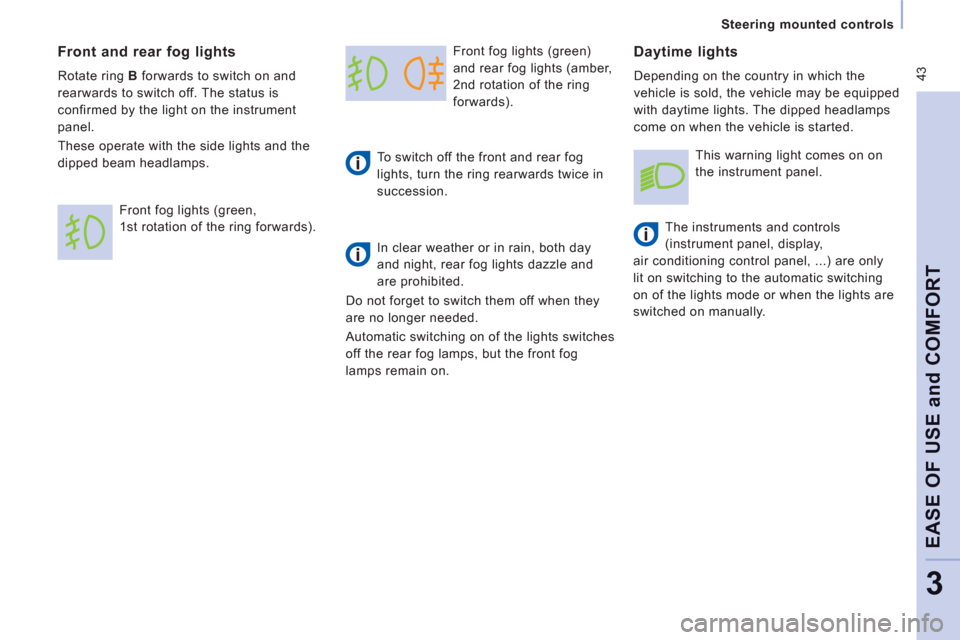
43
Steering mounted controls
EASE OF USE and COMFOR
T
3
Front fog lights (green)
and rear fog lights (amber,
2nd rotation of the ring
forwards).
To switch off the front and rear fog
lights, turn the ring rearwards twice in
succession.
In clear weather or in rain, both day
and night, rear fog lights dazzle and
are prohibited.
Do not forget to switch them off when they
are no longer needed.
Automatic switching on of the lights switches
off the rear fog lamps, but the front fog
lamps remain on. Daytime lights
Depending on the country in which the
vehicle is sold, the vehicle may be equipped
with daytime lights. The dipped headlamps
come on when the vehicle is started.
The instruments and controls
(instrument panel, display,
air conditioning control panel, ...) are only
lit on switching to the automatic switching
on of the lights mode or when the lights are
switched on manually.
Front and rear fog lights
Rotate ring B
forwards to switch on and
rearwards to switch off. The status is
confirmed by the light on the instrument
panel.
These operate with the side lights and the
dipped beam headlamps.
Front fog lights (green,
1st rotation of the ring forwards). This warning light comes on on
the instrument panel.
Page 46 of 268
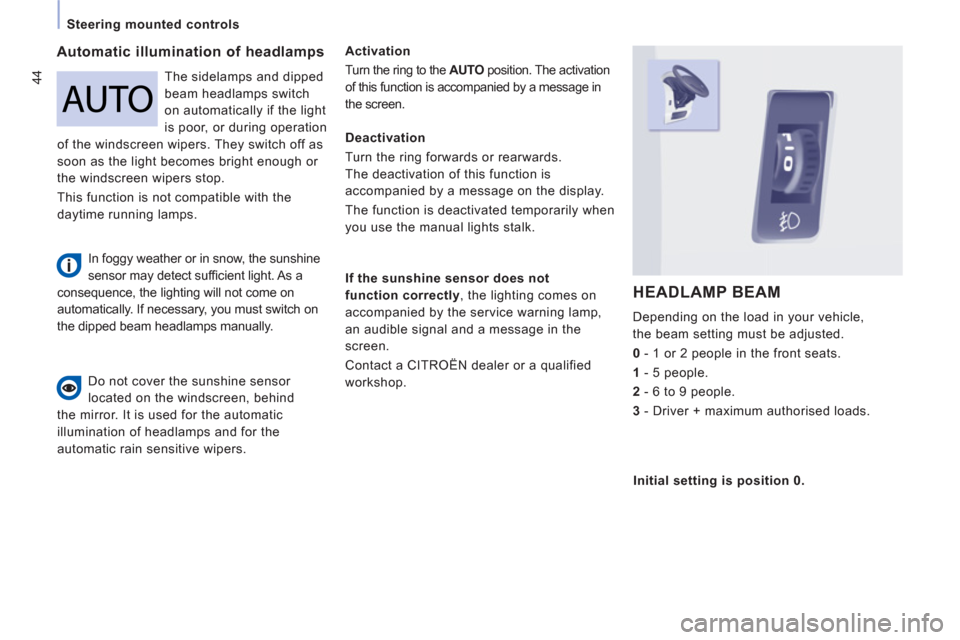
44
Steering mounted controls
Automatic illumination of headlamps
Activation
Turn the ring to the AUTO
position. The activation
of this function is accompanied by a message in
the screen.
If the sunshine sensor does not
function correctly
, the lighting comes on
accompanied by the service warning lamp,
an audible signal and a message in the
screen.
Contact a CITROËN dealer or a qualified
workshop.
HEADLAMP BEAM
Depending on the load in your vehicle,
the beam setting must be adjusted.
0
- 1 or 2 people in the front seats.
1
- 5 people.
2
- 6 to 9 people.
3
- Driver + maximum authorised loads. Do not cover the sunshine sensor
located on the windscreen, behind
the mirror. It is used for the automatic
illumination of headlamps and for the
automatic rain sensitive wipers. The sidelamps and dipped
beam headlamps switch
on automatically if the light
is poor, or during operation
of the windscreen wipers. They switch off as
soon as the light becomes bright enough or
the windscreen wipers stop.
This function is not compatible with the
daytime running lamps.
Deactivation
Turn the ring forwards or rearwards.
The deactivation of this function is
accompanied by a message on the display.
The function is deactivated temporarily when
you use the manual lights stalk.
Initial setting is position 0. In foggy weather or in snow, the sunshine
sensor may detect suffi cient light. As a
consequence, the lighting will not come on
automatically. If necessary, you must switch on
the dipped beam headlamps manually.
Page 47 of 268
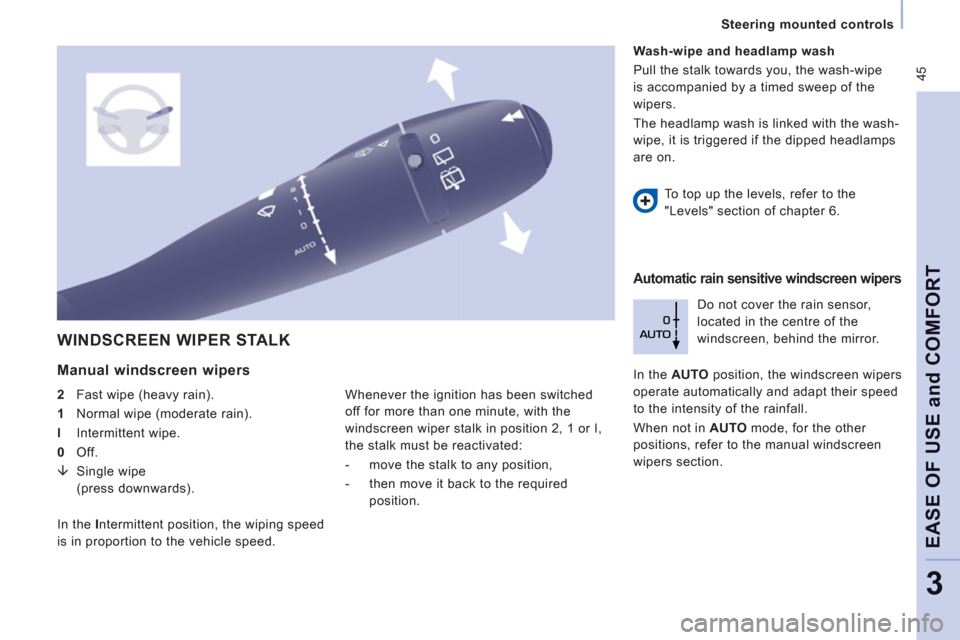
45
Steering mounted controls
EASE OF USE and COMFOR
T
3
WINDSCREEN WIPER STALK
Manual windscreen wipers
2
Fast wipe (heavy rain).
1
Normal wipe (moderate rain).
l
Intermittent wipe.
0
Off.
�È
Single wipe
(press downwards). Do not cover the rain sensor,
located in the centre of the
windscreen, behind the mirror.
In the AUTO
position, the windscreen wipers
operate automatically and adapt their speed
to the intensity of the rainfall.
When not in AUTO
mode, for the other
positions, refer to the manual windscreen
wipers section.
In the I
ntermittent position, the wiping speed
is in proportion to the vehicle speed.
Wash-wipe and headlamp wash
Pull the stalk towards you, the wash-wipe
is accompanied by a timed sweep of the
wipers.
The headlamp wash is linked with the wash-
wipe, it is triggered if the dipped headlamps
are on.
To top up the levels, refer to the
"Levels" section of chapter 6.
Automatic rain sensitive windscreen wipers
Whenever the ignition has been switched
off for more than one minute,
with the
windscreen wiper stalk in
position 2, 1 or I,
the stalk must be reactivated:
- move the stalk to any position,
- then move it back to the required
position.
Page 48 of 268

Steering mounted controls
Special position of the windscreen
wipers
In the minute following switching off of the
ignition, any action on the stalk positions the
wipers against the windscreen uprights. This action enables you to position the
wiper blades for winter parking, cleaning or
replacement.
Refer to the "Changing a windscreen
wiper blade" section of chapter 7.
To park the wipers in their normal position
after this has been done, switch on the
ignition and move the stalk. When using an automatic car wash,
switch off the ignition to avoid
triggering the automatic wiping.
In winter, it is advisable to wait for the
windscreen to completely clear of ice before
operating automatic wipe.
Rear windscreen wiper
Turn the ring to the first notch.
Rear windscreen wash
Turn the ring past the first notch:
the windscreen wash then
the windscreen wiper operate for
a fixed time.
In winter, in the event of a considerable
amount of snow or ice, switch on
the rear screen demister. Once de-icing is
complete, remove the snow or ice which has
accumulated on the rear wiper blade. You can
then operate the rear windscreen wiper.
Activation
Press the control downwards. Activation of the
function is accompanied by a message in the
screen.
The automatic rain sensitive windscreen
wipers function must be reactivated if the
ignition has been switched off for more than
one minute, by pressing the stalk downwards.
Deactivation/Switching off
Place the windscreen wipers stalk in position I
,
1
or 2
. Deactivation of the function is
accompanied by a message in the screen.
In the event of malfunction of the automatic
windscreen wipers, the windscreen wipers
will operate in intermittent mode.
Contact a CITROËN dealer or a qualified
workshop to have the system checked.
Page 49 of 268

47
Steering mounted controls
EASE OF USE and COMFOR
T
3
CRUISE CONTROL "CRUISE"
In order for it to be programmed or
activated, the vehicle speed must be greater
than 25 mph (40 km/h) with at least 4th gear
engaged. Function selected,
display of the "Cruise
Control" symbol.
Function deactivated,
OFF
(example at
107 km/h).
Function activated
(example at 107 km/h).
Vehicle speed above
(e.g. 118 km/h),
the programmed speed
is displayed flashing.
Operating fault detected,
OFF
- the dashes flash. This cruise control shows the function
selection status in the instrument panel and
displays the programmed speed:
"This is the speed at which the driver wishes
to drive".
This aid to driving in free-flowing traffic
enables the vehicle to maintain the speed
programmed by the driver, unless a steep
gradient makes this impossible.
Page 50 of 268

48
Steering mounted controls
Selecting the function
- Place the switch in the CRUISE
position.
The cruise control is selected but is
not yet active and no speed has been
programmed.
First activation/programming a speed
- Reach the chosen
speed by pressing the
accelerator.
- Press the SET -
or SET +
button.
This programmes/activates the reference
speed and the vehicle will maintain this
speed.
Temporarily
exceeding the speed
It is possible to accelerate
and drive
momentarily at a speed greater than the
programmed speed. The value programmed
flashes.
When the accelerator pedal is released, the
vehicle will return to the programmed speed.
Reactivation
- Following deactivation of the cruise
control, press this button.
Your vehicle will return to the last
programmed speed.
Alternatively, you can repeat the "first
activation" procedure.
Deactivation (off)
- Press this button or the
brake or clutch pedal.
Changing the programmed speed
There are two methods of
memorising a speed higher
than the previous one:
Without using the accelerator:
- press the Set +
button.
A brief press increases the speed by 1 mph (km/h).
A maintained press increases the speed in
steps of 5 mph (km/h).